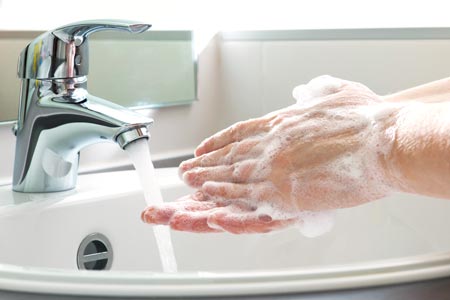
Hand-washing is shown to prevent a variety of diseases and infections.
Interested in a low-cost, do-it-yourself, way to defend against germs?
Try washing your hands with soap. It’s the proven, old-school method that works best.
Your hands are the main carriers of infections and disease-causing germs. In fact, touching things is how most infectious diseases are spread. Hand-washing performed at key moments throughout the day is shown to prevent a variety of diseases and infections.
There are a few misconceptions about hand-washing that health care providers want to clear up.
“Some people are surprised to learn that the temperature of the water doesn’t matter,” said Marilyn Hart, infection prevention specialist at Marshfield Clinic Health System. “Both warm and cold water remove the same number of germs from your hands. It’s the water and soap making a lather that traps and removes the germs from your skin.”
Another surprising note involves soap.
“Plain soap is recommended, not antibacterial,” said Hart. “Studies have not found that antibacterial soap is better than plain soap at preventing people from getting sick.”
Here are a few additional frequently asked questions from the CDC to help get you in the hand-washing habit.
When should I wash my hands?
- Before, during and after preparing food.
- Before eating.
- Before and after caring for someone who’s sick.
- Before and after treating a cut or wound.
- After using the toilet.
- After changing diapers or cleaning up a child who has used the toilet.
- After blowing your nose, coughing or sneezing.
- After touching an animal, animal feed or animal waste.
- After handling pet food or pet treats.
- After touching garbage.
- When your hands are visibly dirty or greasy.
What’s the correct way to wash my hands?
- Wet your hands with clean, running water (warm or cold), and apply soap.
- Lather your hands by rubbing them together with the soap. Be sure to lather the backs of your hands, between your fingers, and under your nails.
- Scrub your hands for at least 20 seconds.
- Rinse your hands well under clean, running water.
- Dry your hands using a clean towel or air dry them.
What should I do if I don’t have soap?
If soap and water are not available, use an alcohol-based hand sanitizer that contains at least 60 percent alcohol.
Alcohol-based hand sanitizers quickly can reduce the number of microbes on hands in some situations, but sanitizers do not eliminate all types of germs.
For questions about the hand-washing, talk to a Marshfield Clinic Health System provider.
Schedule appointment Message your provider
Related Shine365 articles
Should I get the updated COVID-19 vaccine?
Pneumococcal vaccine helping infants and older adults
What’s new with the flu in 2023?
Why do I keep getting COVID-19?

